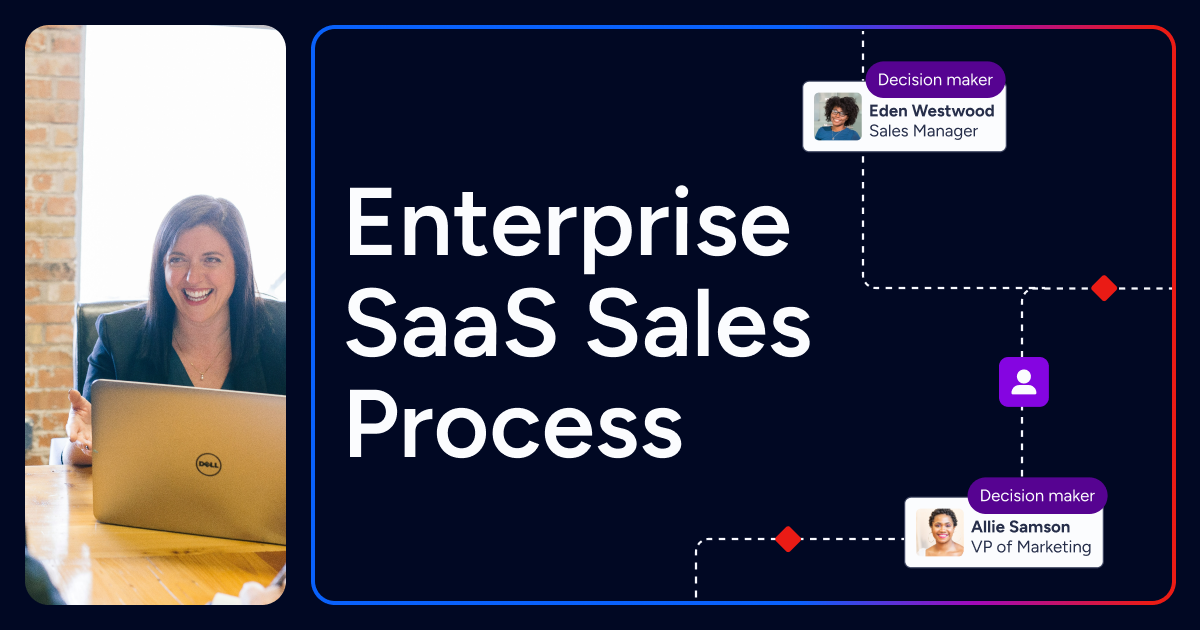Mastering the enterprise software-as-a-service (SaaS) sales process is essential for organizations aiming to secure high-value clients and drive sustainable growth.
Enterprise sales require a strategic approach, deep product knowledge, and the ability to navigate complex business environments. This guide explores the unique dynamics of enterprise SaaS sales, outlines each stage of the process, and provides actionable strategies for sales professionals and business leaders.
What Sets the Enterprise SaaS Sales Process Apart?
Enterprise SaaS sales differ from other models due to their complexity and scale. Unlike SMB sales, enterprise deals involve:
Extended Sales Cycles: Large organizations conduct thorough evaluations of software products, often requiring months of engagement.
Multiple Decision-Makers: Sales teams must address the needs of various stakeholders, including IT, finance, and executive leadership, who all have different goals.
Custom Solutions: Enterprises expect tailored software that aligns with their business processes and objectives.
Large Contract Values: Deals often involve substantial investments, making the sales process more rigorous and consultative.
These factors demand a sophisticated approach to selling, where understanding the prospect’s business and delivering a compelling product solution are vital.
Key Differences: Enterprise SaaS Sales vs. SMB Sales
Enterprise SaaS sales focus on solving complex business challenges with robust software solutions. The process requires:
Advanced Product Capabilities: Enterprise clients seek software with extensive features, integrations, and security.
Relationship Management: Building trust with prospects is critical. Sales teams must engage stakeholders across departments.
Cross-Functional Collaboration: Success depends on alignment between sales, marketing, product, and customer success teams.
Targeted Marketing: Marketing teams play a crucial role in generating qualified leads and supporting the sales process with relevant content.
The SaaS Sales Model: A Focus on Service and Success
The SaaS sales model is fundamentally different from traditional selling. Instead of a one-time transaction, SaaS sales revolve around ongoing service, value delivery, and partnership. This model transforms the relationship between provider and client into a continuous journey, where success is measured not just by the initial software sale, but by long-term adoption, satisfaction, and business outcomes.
Service at the Core:
In enterprise SaaS sales, the product is delivered as a service — constantly updated, improved, and supported. Sales teams must communicate not only the features of the software, but also the quality of service, support, and expertise that come with it. This means setting clear expectations for onboarding, training, and ongoing support, ensuring the prospect understands the full value of the partnership.
Customer Success as a Growth Engine:
The SaaS sales process doesn’t end at closing. Customer success teams play a pivotal role in driving adoption, resolving challenges, and identifying opportunities for expansion. By proactively engaging with clients, monitoring usage, and providing tailored recommendations, customer success professionals help maximize the business impact of the software. This focus on service leads to higher retention rates, more upsell opportunities, and stronger business relationships.
Aligning Sales, Marketing, and Product:
A successful SaaS sales model requires tight alignment between sales, marketing, and product teams. Marketing generates qualified leads and educates prospects, sales guides them through the buying journey, and product teams ensure the solution evolves to meet changing business needs. This collaborative approach ensures that every stage of the sales process is focused on delivering value and driving customer success.
Measuring Success Beyond the Sale:
Key metrics in the SaaS sales model include customer lifetime value, net promoter score, and product adoption rates. These indicators reflect the ongoing health of the business relationship and the effectiveness of the sales process in delivering real, measurable outcomes for the customer.
In the enterprise SaaS world, selling is not just about closing deals—it’s about building lasting partnerships, delivering continuous value, and ensuring every client achieves success with your software.
Understanding the Importance of Customization in SaaS Sales
Customization is a cornerstone of successful enterprise SaaS sales. Unlike off-the-shelf software, enterprise clients expect solutions that fit their unique business requirements. Customization demonstrates a deep understanding of the prospect’s operations, challenges, and goals.
A tailored product approach allows sales teams to:
Address Specific Business Needs: By customizing features, integrations, and workflows, the software becomes a true solution for the client’s business.
Increase Stakeholder Buy-In: When stakeholders see their requirements reflected in the product, they are more likely to support the purchase decision.
Differentiate from Competitors: Customization sets your SaaS product apart in a crowded market, showing prospects that your business is committed to their success.
Drive Long-Term Value: Customized solutions are more likely to be adopted, integrated, and expanded within the client’s organization, leading to higher retention and upsell opportunities.
Sales professionals should work closely with product and marketing teams to ensure that customization options are clearly communicated throughout the sales process. Demonstrating flexibility and a willingness to adapt the software to the client’s business is a powerful differentiator in enterprise sales.
Stages of the Enterprise SaaS Sales Process
A well-defined sales process increases efficiency and improves outcomes. The typical enterprise SaaS sales funnel includes:
1. Lead Generation
Effective lead generation relies on data-driven marketing and sales intelligence. Identifying high-potential prospects ensures resources focus on opportunities with the greatest business impact.
2. Discovery
Discovery involves in-depth conversations to understand the prospect’s business needs, pain points, and goals. This stage sets the foundation for a tailored product demonstration.
3. Solution Alignment
Sales teams present the software solution, highlighting features that address the prospect’s specific challenges. Demonstrating business value and ROI is essential.
4. Stakeholder Engagement
Engaging all relevant decision-makers is critical. Sales professionals must adapt their messaging to resonate with each stakeholder’s priorities and concerns.
5. Proposal and Negotiation
Proposals should reflect the prospect’s requirements and business objectives. Negotiations often involve legal, security, and compliance considerations unique to enterprise software.
6. Closing and Onboarding
A seamless onboarding process accelerates product adoption and sets the stage for long-term business relationships. Customer success teams play a vital role in ensuring satisfaction and retention.
Building Strong Client Relationships in Enterprise Software Sales
In enterprise SaaS sales, relationships are the thread that weaves through every stage of the sales process. Success depends on more than just mapping the org chart; sales teams must uncover informal networks, identify true influencers, and understand internal dynamics. Go beyond titles to discover who drives decisions and who can champion your product.
Craft stakeholder-specific value propositions by tailoring your messaging and demos to each group’s unique priorities, whether that’s IT’s need for integration or leadership’s focus on ROI. Empower your internal champions with resources and support, enabling them to advocate for your solution within their organization.
Finally, maintain collaboration after the deal closes. Ongoing engagement through onboarding, training, and regular business reviews not only builds trust but also opens doors for future expansion and referrals. In enterprise SaaS sales, strong relationships turn prospects into long-term partners.
Overcoming Enterprise SaaS Sales Challenges
Enterprise sales professionals face several obstacles:
Prolonged Sales Cycles: Maintain momentum by setting clear milestones and leveraging analytics to identify and address bottlenecks.
Complex Negotiations: Prepare for detailed discussions around software capabilities, pricing, and compliance.
Stakeholder Alignment: Use data, case studies, and product demonstrations to build consensus and validate the solution’s business value.
How Can Businesses Measure the Success of Their Enterprise Sales Strategies?
Key performance indicators for enterprise sales include:
Deal Velocity: Speed at which opportunities progress through the sales process.
Win Rate: Percentage of closed deals relative to total opportunities.
Customer Retention: Rate of contract renewals and product expansion within existing accounts.
Upsell and Cross-Sell: Ability to grow revenue by selling additional features or services to current clients.
Leveraging Technology in the Enterprise Sales Process
Go-to-market (GTM) intelligence is transforming the enterprise SaaS sales process. In a landscape where sales cycles are long and buying committees are complex, having actionable intelligence is critical for success.
What tools and technologies are essential for optimizing the enterprise SaaS sales process?
GTM Intelligence Platforms:
Go-to-Market Intelligence Platforms like ZoomInfo equip sales and marketing teams with real-time company data, contact information, intent signals, and organizational charts with AI-driven next-step recommendations. This empowers your team to identify and prioritize high-value leads, map out key decision-makers, and engage prospects with personalized, relevant messaging.
Integrated Workflows and Automation:
Seamless integration with CRM and marketing automation tools ensures that GTM insights are embedded directly into your sales process. Automation streamlines lead enrichment, scoring, and outreach, allowing your sales team to focus on building relationships and advancing deals.
Data-Driven Strategy and Execution:
With robust analytics and reporting, sales leaders can monitor pipeline health, optimize territory planning, and uncover new opportunities for upselling and cross-selling. ZoomInfo’s GTM intelligence enables you to make informed decisions at every stage, accelerating the sales cycle and increasing win rates.
By leveraging go-to-market intelligence from ZoomInfo, enterprise SaaS sales teams gain a strategic advantage—turning data into actionable insights, driving targeted engagement, and maximizing revenue across the entire sales process.
The Future of Enterprise SaaS Sales
The enterprise SaaS landscape continues to evolve.
Trends such shaping the future of enterprise sales include:
AI-driven insights
Increased personalization
A focus on customer success
Sales teams that embrace technology, adapt their strategies, and prioritize business value will remain competitive.
Elevate your enterprise SaaS sales process with ZoomInfo. Leverage advanced sales intelligence to identify qualified leads, engage the right prospects, and accelerate your sales cycle. Equip your team with the tools and insights needed to deliver exceptional business outcomes.


